Is Walking Every Day Enough Exercise to Stay Fit?
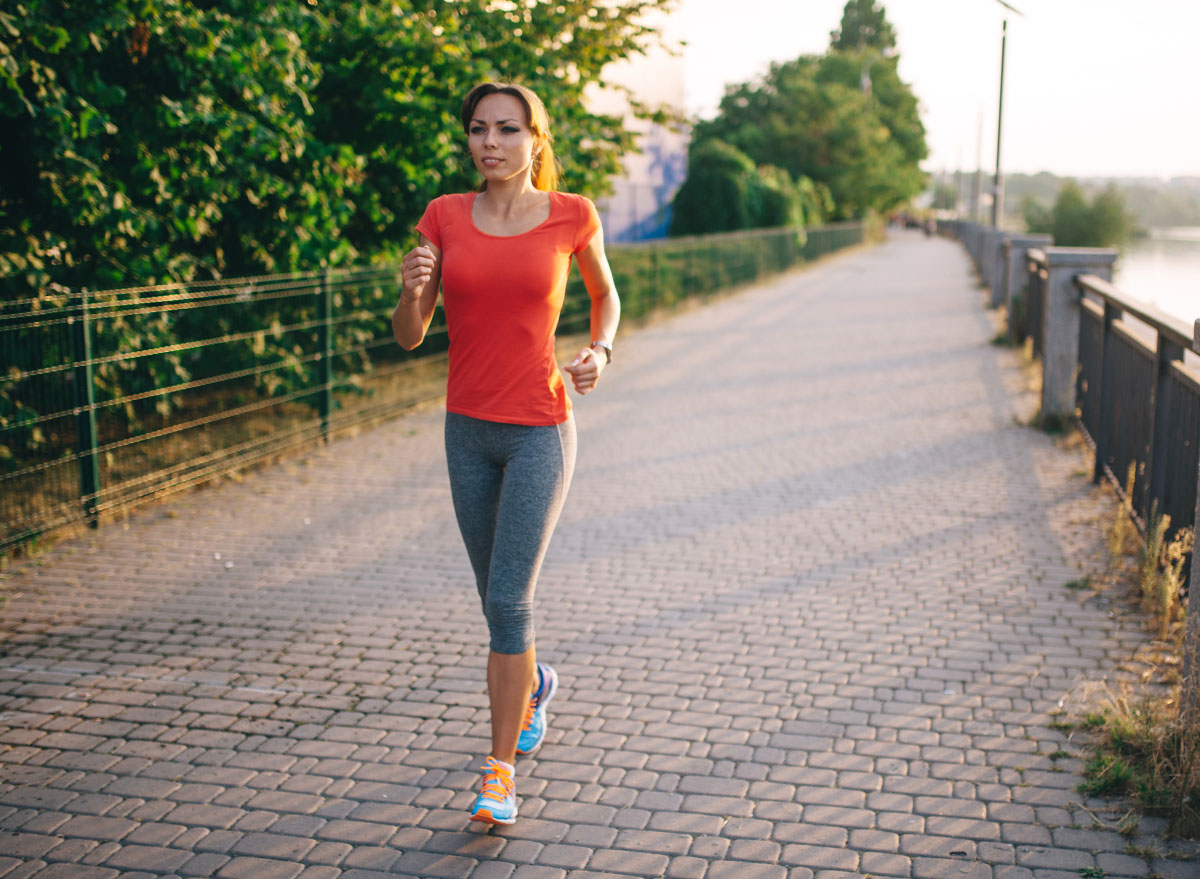
With trendy walking techniques like the 12-3-30 incline treadmill routine, rucking, and the Japanese walking method making waves on social media, it’s no surprise this simple form of cardio has become a fan favorite. But does a daily walk truly keep the calories away? This popular workout can be done anywhere and pretty much any time of day, and research shows it can work wonders on your waistline while keeping your heart strong. However, if it’s your only form of exercise, you’re likely wondering whether a walk a day is enough to keep you fit as a fiddle.
Jordan Fernandez, CPT from Trainer Academy, sums it up in a nutshell: “Whether walking every day is ‘enough exercise’ depends entirely upon your goals, current fitness level, phase of life, and many other factors. If walking is your only form of exercise and your goal is to continually improve your fitness, you will need to increase the intensity by either doing more aggressive hills, longer distances, or increasing the speed of your walk.”
It’s really goal-specific for each individual.
Walking Every Day Should Be Adequate to Maintain Aerobic Fitness.

If your goal is to maintain aerobic fitness and stay within the recommended weekly guidelines, getting in your steps should be adequate if you crank up your pace and heart rate for a solid 30 to 60 minutes per day. However, if you’re looking to build strength and muscle, then you likely won’t accomplish that by just walking.
The Physical Activity Guidelines for Americans suggest adults complete at least 150 to 300 minutes of moderately intense or 75 to 150 minutes of vigorous aerobic exercise each week. However, the guidelines also recommend performing at least two days of muscle-strengthening activities per week. This means weaving bodyweight exercises and free weights into your regimen.
“Mixing in strength exercises with a walk challenges muscles that are not used much with regular walking. Bodyweight exercises such as squats, lunges, step-ups or bench push-ups can increase tone, joint support and stability,” notes Denise Chakoian, Rhode Island certified fitness trainer and owner of Core Cycle and Fitness La Gree. “More muscle strength can also support good posture, help prevent injury, and allow for more comfortable longer walks. Adding resistance bands, light hand weights, or a weighted vest can increase calorie burn and preserve lean muscle, which is important as we age.”
By blending walking with strength training, you establish a well-balanced fitness routine that supports body conditioning and stamina.
Walking Can Help You Melt Body Fat
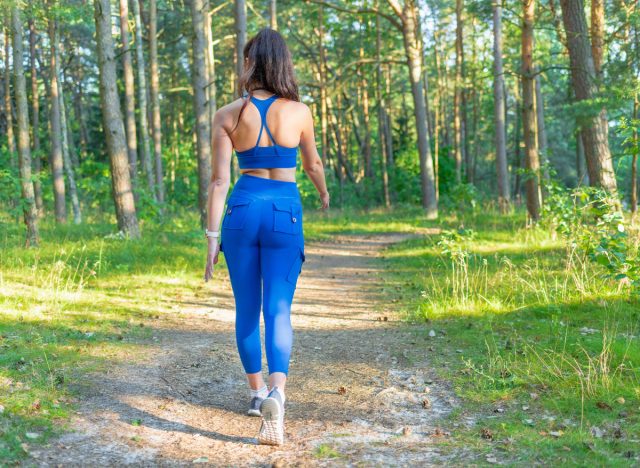
According to Domenic Angelino, MS, CSCS, FNS, CPT, from Trainer Academy, walking can help you melt unwanted body fat and lose weight.
“It’s not necessarily more or less effective than other methods in that you’re still just burning calories at the end of the day,” Angelino explains. “But it can help you burn more calories than you otherwise would. If you fit in an extra 15-minute walk or so a few times a week, you’d hit your fat-loss goals even faster.”
The great thing about walking is that it can seamlessly be incorporated into other comprehensive workout regimens without significantly increasing fatigue.
Walking Can Improve Overall Quality of Life.
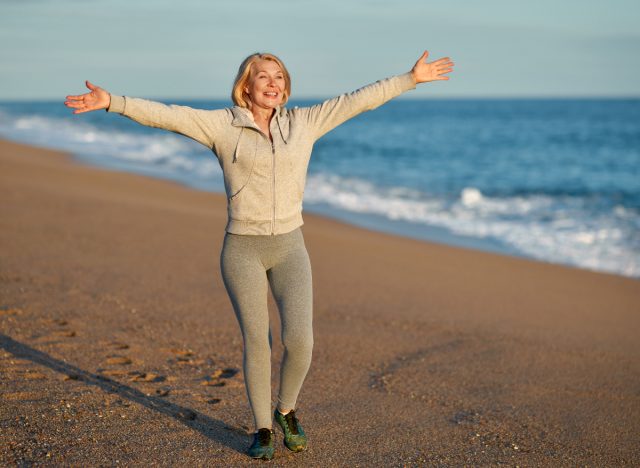
Walking daily can boost your overall quality of life and make other physical activities feel more doable.
“If you walk regularly at a brisk pace, you’ll find that taking many flights of stairs will start to feel easier on your body,” Angelino tells us. “This effect will be amplified if you regularly walk up hills with steep inclines because you’ll engage muscles in a more similar way to how you would when walking up the stairs. For example, you’ll recruit your glutes in a more similar way than if you were walking on a flat surface.”
Daily Walking Targets
How many steps should you aim for, exactly? While the daily goal has long been considered 10,000 steps, new research shows that may not necessarily be the case. A study from the University of Sydney found that walking 7,000 steps a day provides similar health benefits as walking 10,000.
In fact, according to professor Melody Ding from the School of Public Health, who led the research, ”We know daily step count is linked to living longer, but we now also have evidence that walking at least 7,000 steps a day can significantly improve eight major health outcomes—including reducing risk of cardiovascular disease, dementia and depressive symptoms.”
Keep in mind that even small increases in your daily step count—from 2,000 to 4,000, for instance—still make a major difference. They also make your walking goals more sustainable for the long-term.
Morning Versus Post-Meal Walks
When trying to determine what time of day is best to plan your walk, McDowell assures both come with their own benefits.
“Morning walks boost cortisol (the hormone that wakes you up!) and if you do them outside, are a great way to get the benefits of healthy sun exposure for Vitamin D production,” McDowell explains. “Post-meal walks help with blood glucose management and gut motility.”
The best choice for you comes down to your goal. “Mornings are ideal for boosting mood and establishing routine, while post-meal walks target digestive and metabolic health. Many people benefit most by including both at different times,” says Chakoian.
Trending Walking Methods
@laurengiraldoGame changer honestly♬ original sound – Lauren Giraldo
From wearing a weighted vest to bumping up the incline on your treadmill, there are many exciting ways you can spice up your daily walking session.
12-3-30 Treadmill Walking Workout
The 12-3-30 method is quite simple: Set your treadmill incline to 12% and maintain a speed of 3 miles per hour for 30 minutes. This is a great way to upgrade your indoor walking workout.
“While straight forward, two things are quite important. The first is to work yourself up to that incline level slowly. Three miles per hour is a brisk enough pace that when adding incline, it won’t take much to add intensity,” says Joy Puleo, NPCP, ACSM certified, Balanced Body education director at Balanced Body. “Between gravity and the additional demands on specific muscles of the lower body, including hamstrings and glutes, there is balance, coordination as well as cardiovascular endurance that will be challenged, please step up slowly into these challenges.”
@naireekiana this is your sign to stop sleeping on incline walking —this method is my latest cardio obsession for noticeable results! 🖤 wearing @ECHT APPAREL athlete crop jacket, running shorts & midriff singlet! #workout #workoutmotivation #workoutroutine #workoutplan #cardioworkout #cardioroutine #fatloss #echtapparel #echt ♬ headlock x jinx from arcane – ZOMBIE
Zone Zero

“Zone zero” is an easy way to bump up daily movement through activities that don’t really feel like traditional “exercise.” This low-intensity, low-stress trend includes things like slow walking and performing gentle stretches while streaming an audiobook or podcast.
“This approach keeps the heart rate well below the usual aerobic range. At this pace, the body learns to draw on fat for a steady supply of energy, which supports endurance, weight management, and overall metabolic function,” says Chakoian. “Its gentle nature makes it possible to go longer without needing much recovery, so it can easily be done every day. Many people choose it for the days between harder workouts as a way to keep moving while still giving their muscles a break.”
Japanese Walking Method
@nonetorun The Japanese walking secret that’s better than counting steps 🚶♀️ Not ready to run? No problem! Stroll and Stride is the perfect way to get incredible health benefits with just walking 💪 ✨ 3 min slow, 3 min fast – that’s it! ✨ 20% fitness boost in 5 months ✨ 50% less depression ✨ Way better than just hitting 10K steps Free in the None to Run app! Link in bio 👆 #StrideAndStroll #NoneToRun #WalkingFitness #JapaneseWalking #IntervalWalking #BeginnerFriendly #FitnessHacks #HealthyLifestyle #WalkingWorkout #FitnessJourney #GetActive #LowImpact #FitnessForEveryone #WalkingTips #healthtips ♬ sail away (instrumental) – lovelytheband
Japanese walking isn’t brand new, but it’s more recently gained traction on TikTok. It requires you to walk at a high intensity for three minutes, then a low intensity for three more minutes. You repeat this sequence for 30 minutes in total, four times a week.
“This method emphasizes keeping the spine upright, the core active, and each step intentional, often paired with steady, mindful breathing. When practiced over time, it can improve circulation, strengthen the hips and legs, and encourage healthier joint alignment,” explains Chakoian. “By easing the load on the knees and lower back, it makes walking feel smoother and more sustainable. It can facilitate prolonged walking without fatigue. The breathing patterns often used in this method can also help quiet the mind and deliver more oxygen to the body.”
Rucking
Rucking adds a challenging yet beneficial strength element to your daily cardio session. It requires you to wear a weighted rucksack while walking or hiking, which revs up the calorie burn, increases muscle strength, and boosts bone density.
Tips To Maximize the Benefits of Your Walking Workout
To ensure your walking workout is the best it can possibly be, the experts provide a few tips.
Choose Inclines or Stairs Whenever Possible

When the opportunity presents itself, opt for the incline or stairs.
“This will recruit more muscle fibers, increase the intensity of your walk, burn more calories, and improve your cardiorespiratory fitness,” Angelino explains. “It’s beneficial for a whole host of reasons. This can also be used as a form of progression if you want. If you’re working up to running, you can use incline or stair walking as a stepping stone to transition from walking on flat surfaces.”
Recruit a Walking Buddy

Exercising with a friend makes the activity so much more enjoyable and motivates you to get it done.
“If you have a friend that you want to spend time with, it’s totally possible to structure it around a walk,” Angelino suggests. “This lets you reframe the exercise as something totally different: a fun social activity. Walking feels a lot less intrusive in your life when you do it in order to achieve some other goal, like [spending] time with a friend.”
Maintain a Brisk Pace
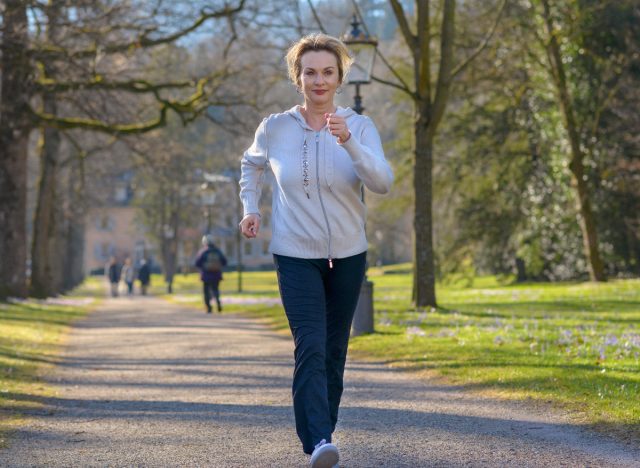
When it comes to walking speed, make sure to maintain a brisk pace that’s comfortable for you. It’s all about finding that “sweet spot.”
“It can be easy to fall into the trap of walking super casually,” says Angelino. “If you walk faster, you’ll burn more calories and experience greater health and fitness benefits. It’s important to be careful, though. If you walk too fast, you might [feel] a bit fatigued, [making] it harder to motivate yourself to walk more in the future.”
Hydrate
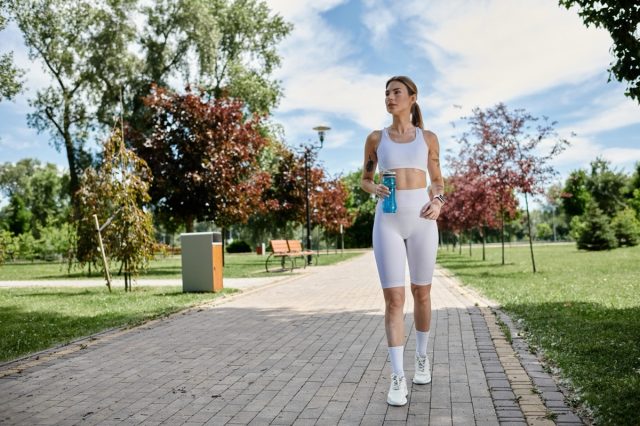
Make sure you bring a water bottle with you and stay sufficiently hydrated during your walk.
“It can be easy to overlook the importance of water when walking due to it being such a low-impact activity,” Angelino explains. “However, staying properly hydrated can help you naturally extend the length of your walk. If you find that you’re physiologically uncomfortable for any reason during your walk, you’ll be less likely to want to extend it.”
Be Consistent
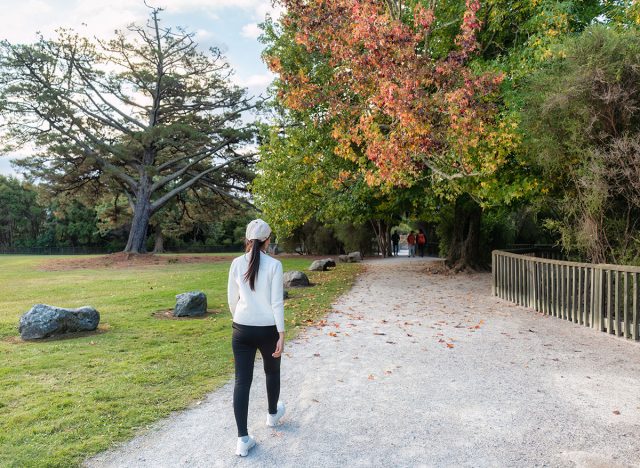
If you want to see real results, consistency is key.
“Schedule the time to walk and do not reschedule,” says Dr. Milica McDowell, doctor of PT, exercise physiologist, and VP of operations at Gait Happens. “Walk while you take a phone call or a meeting to boost your productivity. Swap an activity that doesn’t serve you for a walk and don’t look back!”
Wear Proper Footwear
Wearing the right walking shoes can make all the difference in the world. Make sure they fit properly and are specifically designed for walking—not running.
“Make sure you are wearing shoes designed for walking that fit you properly,” McDowell notes. “Research shows over 60% of adults are consistently wearing the wrong size (length) shoe, as adult feet DO change throughout our lives!”
Looking for more easy ways to lose fat? Here’s How Long Your Walking Workout Should Be To Shrink Belly Fat.